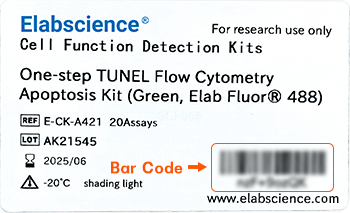RNF5 Polyclonal Antibody (E-AB-13566)

For research use only.
| Verified Samples |
Verified Samples in WB: Jurkat, 231, K562 Verified Samples in IHC: Human thyroid cancer |
| Dilution | WB 1:500-1:2000, IHC 1:25-1:100 |
| Isotype | IgG |
| Host | Rabbit |
| Reactivity | Human, Mouse, Rat |
| Applications | WB, IHC |
| Clonality | Polyclonal |
| Immunogen | Synthetic peptide of human RNF5 |
| Abbre | RNF5 |
| Synonyms | E3 ubiquitin protein ligase RNF5, E3 ubiquitin-protein ligase RNF5, G16, HsRma1, NG2, OTTHUMP00000029107, Protein G16, RING finger protein 5, RING5, RMA1, RNF 5, RNF5, Ram1 homolog |
| Swissprot | |
| Calculated MW | 20 kDa |
| Cellular Localization | Membrane. Mitochondrion membrane. Endoplasmic reticulum membrane. Predominantly located in the plasma membrane, with some localization occurring within cytoplasmic organelles. |
| Concentration | 0.5 mg/mL |
| Buffer | Phosphate buffered solution, pH 7.4, containing 0.05% stabilizer and 50% glycerol. |
| Purification Method | Affinity purification |
| Research Areas | Cancer, Cell Biology, Immunology, Microbiology |
| Conjugation | Unconjugated |
| Storage | Store at -20°C Valid for 12 months. Avoid freeze / thaw cycles. |
| Shipping | The product is shipped with ice pack,upon receipt,store it immediately at the temperature recommended. |
| background | The protein encoded by this gene contains a RING finger, which is a motif known to be involved in protein-protein interactions. This protein is a membrane-bound ubiquitin ligase. It can regulate cell motility by targeting paxillin ubiquitination and altering the distribution and localization of paxillin in cytoplasm and cell focal adhesions. |
Other Clones
{{antibodyDetailsPage.numTotal}} Results
-
{{item.title}}
Citations ({{item.publications_count}}) Manual MSDS
Cat.No.:{{item.cat}}
{{index}} {{goods_show_value}}
Other Formats
{{formatDetailsPage.numTotal}} Results
Unconjugated
-
{{item.title}}
Citations ({{item.publications_count}}) Manual MSDS
Cat.No.:{{item.cat}}
{{index}} {{goods_show_value}}
-
IF:{{item.impact}}
Journal:{{item.journal}} ({{item.year}})
DOI:{{item.doi}}Reactivity:{{item.species}}
Sample Type:{{item.organization}}
-
Q{{(FAQpage.currentPage - 1)*pageSize+index+1}}:{{item.name}}





